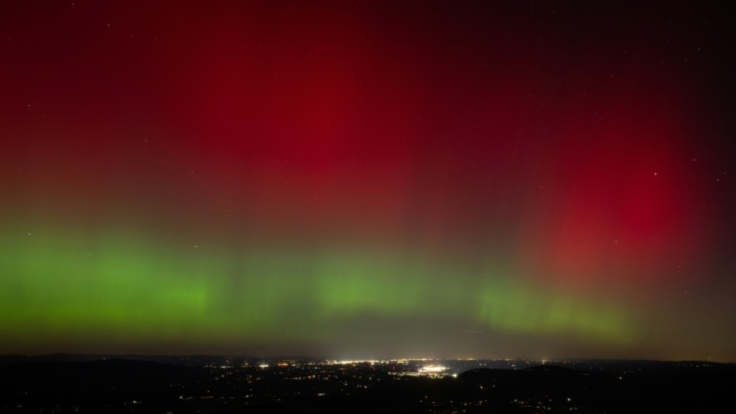Aurora Borealis Forecast Shows Rare 'Cannibal CME' Event — Scientists Say It Could Rival the 2024 Superstorm
Northern lights could be seen across northern Europe, the UK, and parts of North America on 12–13 November

A rare solar storm may light up the northern sky this week and could briefly affect satellites and power systems. Scientists warn that an incoming 'cannibal' coronal mass ejection (CME) may rival the extraordinary May 2024 storm.
The event occurs when one solar eruption overtakes another, merging into a single, larger wave of charged particles and magnetic fields. Sunspot AR4274 has produced multiple strong X-class flares since early November, making this storm particularly unusual.
Forecasters say the storm may reach severe levels on the geomagnetic scale, producing auroras visible far beyond the polar regions. The merged CMEs could also cause temporary disruption to satellites, navigation and power networks.
What Is a 'Cannibal CME'?
A coronal mass ejection is a burst of solar plasma and magnetic fields ejected from the Sun's atmosphere. A 'cannibal' CME occurs when a faster eruption overtakes a slower one, creating a larger and more complex cloud of charged particles. This can intensify geomagnetic storms when the merged CME interacts with Earth's magnetic field, according to EarthSky.
Modelling suggests the combined CME could produce longer-lasting auroras with greater intensity than typical events. Scientists emphasise, however, that the effects will vary depending on the orientation of the solar magnetic field, known as the Bz component, which determines how strongly the storm interacts with Earth's magnetosphere.
Where and When to See It
If the storm unfolds as expected, auroras could be visible across much of Scandinavia, northern England, and Scotland, and possibly further south from darker rural locations. UK viewers are advised to seek clear skies away from city lights and to watch the northern horizon after dark for the best chance of seeing the display, according to Space.com.
Across North America, visibility could extend into the northern United States, while central Europe may also witness bright auroral activity. Peak displays are likely in the hours immediately following the storm's arrival, forecast for late on 12 November or early on 13 November, depending on the solar wind's speed.
Potential Risks and Wider Impact
Although the incoming storm is predicted to reach G4, or severe, on the geomagnetic scale, it is one step below the most extreme category, G5. Even so, severe geomagnetic storms can temporarily affect power grids, disrupt satellite navigation and radio communications, and increase radiation exposure on polar flight routes, according to ScienceAlert.
The May 2024 superstorm, which reached G5, produced auroras as far south as Florida and northern Africa and caused brief satellite signal disruptions. While this event is unlikely to match that intensity, scientists say the cannibal CME's dynamics mean it could still be among the most significant space-weather events of the year.
KP 8.67 Severe Geomagnetic Storm G4 Increase in aurora activity, space weather health risk, and technological outages. pic.twitter.com/rHjMNqgHdK
— Carrington App (@CarringtonApp) November 12, 2025
A strong geomagnetic storm recently caused remarkable night-sky phenomena.
— AIdriving (@mrc_748) November 12, 2025
This was filmed last night.
The past month brought cosmic events like the flyby of comet #c2025v1 Borisov and the ongoing presence of #3IATLAS within the Solar System. pic.twitter.com/8IXklv1ezH
Here’s some extra shots of the remarkable red colour of the Aurora Borealis / Northern Lights over Courtmacsherry areas in West Cork , Ireland as that intense Geomagnetic Storm continues!! 🤩🥰📸🌠🌌💥🌊✨💚♥️ #auroraborealis #aurora #NorthernLights #merrydancers… pic.twitter.com/tjeAo8HjxJ
— Alan Mac Cárthaigh 🇮🇪 (@AlanMcC82) November 12, 2025
EARTH IS BEING ROCKED ⚡
— Michael Bradbury (@MrMBB333) November 12, 2025
A powerful G4 geomagnetic storm is in progress — Kp Index 9.
Earth’s field is under extreme stress, and many are feeling it:
ringing ears, fatigue, restlessness, vivid dreams.
The planet’s frequency is surging tonight. 🌍#MrMBB333 #SolarStorm #Aurora pic.twitter.com/28rV4lwdKm
The KP Index skyrocketed to almost 9 so fast!
— Jordan Crowder (@digijordan) November 12, 2025
9 is the highest. That would be a G5 severe geomagnetic storm.
And this is with the arrival of just the first of three CMEs…
The last one is the strongest.
Buckle up folks! pic.twitter.com/ygOBHZgCZN
Scientists Urge Perspective
Experts stress that solar storms are a natural part of the Sun's 11-year cycle, with increased activity during solar maximum. The vivid aurora spectacle comes with inherent uncertainty as cloud cover, magnetic orientation and local conditions may all influence visibility.
Whether this week's storm becomes a once-in-a-decade light show or a moderate display will depend on a few unpredictable solar variables. For UK and northern-hemisphere viewers, it is an opportunity to witness a rare natural phenomenon while also serving as a reminder of the ongoing influence of solar activity on modern technology.
© Copyright IBTimes 2025. All rights reserved.




















